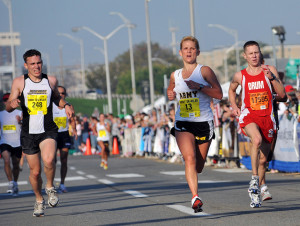- Calls to this hotline are currently being directed to Within Health or Eating Disorder Solutions
- Representatives are standing by 24/7 to help answer your questions
- All calls are confidential and HIPAA compliant
- There is no obligation or cost to call
- Eating Disorder Hope does not receive any commissions or fees dependent upon which provider you select
- Additional treatment providers are located on our directory or samhsa.gov
Competitive Female Athletes & Anorexia Nervosa

Contributor: Margaret Garrity, RD, LDN, Director of Nutrition Services, Timberline Knolls Residential Treatment
The American culture has long been obsessed with the importance of being thin, especially in the female population. Girls, adolescents and adults alike feel the pressure to be thin every day.
Additionally, throughout recent decades, our society has become ever more focused on fitness and exercise. This creates a perfect storm for women and girls in the general population to diet and work out excessively. By and large, such behavior receives across-the-board approval and reinforcement from family and friends.
The world of competitive athletics presents a whole new, and worrisome, problem for females.
This concern does not extend to group sports such as soccer and basketball; instead, the problem is confined to individual sports where the scrutiny is on a single person’s performance and appearance versus an entire team.
Participation in such activities as gymnastics, ballet, dance and ice skating, often starts at a very young age. Young girls quite routinely attend classes, even workshops, to refine their individual skills in a specific sport.
If even a modicum of innate talent is displayed and if parents have the time and resources, these skills are frequently nurtured into the pre-teen and adolescent years. And, that is when disordered eating can begin, and anorexia can take hold.
Female Athletes and Anorexia
The human body is designed to grow and mature according to a certain predetermined timeline. Girls are intended to eventually grow into women.

As these very normal changes begin, it is not unusual for coaches and trainers to personally weigh their female athletes and place them on calorie-restricting diets.
The same holds true in endurance sports such as track and field, running, swimming or diving. Although these are less appearance-driven than ballet and dance, the perception is that a lower weight will improve the athlete’s performance.
Young female athletes often share similar personality traits: they are often highly competitive and disciplined, perfectionistic, and importantly, very eager to please their coaches and trainers. If this means starving themselves, then that is what it takes.
If severe restriction is started in the pre-teen years, menses and all that it implies can be negated completely. If body fat is too low, a female will not menstruate, simply because her body cannot sustain a pregnancy; therefore the possibility is not placed on the biological table.
Amenorrhea is still viewed as a red flag for diagnosable anorexia and has immediate and long-term medical consequences of its own.
Calcium and bone-loss can lead to stress fractures and over time can result in osteoporosis.

Much of this involves the coaches. It is helpful if they have a positive, person-oriented style instead of a negative, performance-obsessed coaching style.
It is also preferable to have a coach who is more concerned with an athlete’s motivation and enthusiasm rather than body weight or shape.
Parents also need to be onboard, recognizing that the human body will change and develop as a girl ages and that is not a bad thing.

As Director of Nutrition Services, Maggie‘s job entails many duties. She oversees the dietitians and diet technicians, carries a caseload of adolescents, supervises the menu and meal planning stages and develops nutrition-related protocols. She also implements current nutrition recommendations, participates in community outreach and trains dietitians.
Prior to joining Timberline Knolls, Maggie was the Nutrition Manager at Revolution in Chicago. She started with Timberline Knolls as a diet technician and progressed to a Registered Dietitian.
Maggie attended Eastern Illinois University for her undergraduate degree in Dietetics and Nutrition and then completed her dietetic internship at Ingalls Memorial Hospital.
She is a member of the Academy of Nutrition and Dietetics, Behavioral Health DPG and South Suburban Academy of Nutrition and Dietetics.
The opinions and views of our guest contributors are shared to provide a broad perspective of eating disorders. These are not necessarily the views of Eating Disorder Hope, but an effort to offer discussion of various issues by different concerned individuals.
We at Eating Disorder Hope understand that eating disorders result from a combination of environmental and genetic factors. If you or a loved one are suffering from an eating disorder, please know that there is hope for you, and seek immediate professional help.
Published on January 12, 2018.
Reviewed By: Jacquelyn Ekern, MS, LPC on January 12, 2018.
Published on EatingDisorderHope.com
